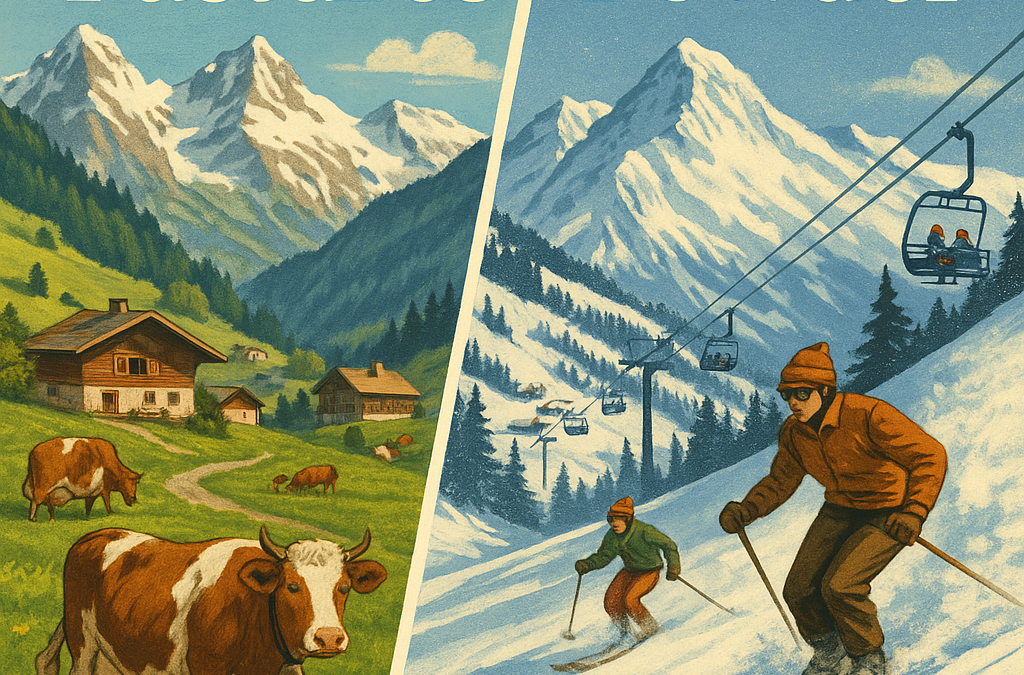
Nestled in the heart of the French Alps, Châtel began its journey as a humble farming community, its roots stretching back to the 12th century. For centuries, life here was dictated by the rhythm of the seasons. In summer, families moved their herds up to lush alpine pastures, where the sound of cowbells drifted across the meadows. The prized Abondance cattle—known for their rich milk—grazed freely, producing the cheese that still carries the village’s name. Winters were long, quiet, and often harsh, with locals relying on stored provisions, woodcutting, and craftsmanship to see them through until spring.
Despite its pastoral traditions, Châtel’s landscape held untapped potential. The towering peaks, sweeping valleys, and crisp mountain air had a natural allure. Before skiing took hold, visitors came mainly in summer for hiking, fresh air, and even spa retreats, taking advantage of the restorative alpine climate. But all that began to change in the mid-20th century.
The transformative pivot toward winter tourism began in earnest after World War II. In 1947, the installation of Châtel’s first drag lift at Vonnes marked the village’s leap into the ski industry. For the first time, visitors could glide down snowy slopes instead of trudging up them. Just a year later, local ski pioneer Roland Macchi founded Châtel’s first ski school. His daughter, Françoise Macchi, would go on to become one of France’s most celebrated alpine ski racers, putting the small village firmly on the map.
The 1950s were a decade of rapid expansion. The Morclan slopes were soon equipped with both drag and chair lifts. Hotels sprang up in the village and partway up the mountain, catering to a new breed of winter traveller. “Super-Châtel” became the heartbeat of this growth, offering wide-open pistes with panoramic views across the Franco-Swiss border. In fact, cross-border skiing was a Châtel tradition long before it was formalised—locals and visitors alike would ski into the neighbouring Swiss village of Morgins as casually as they might stroll to the next hamlet.
By the late 1960s, Châtel had become a key player in larger regional ambitions. The opening of the Linga area in 1967, with its gondola and north-facing slopes, introduced terrain famed for its deep, dry powder and exceptional snow retention. Châtel’s location—at the confluence of maritime and continental weather systems—meant it regularly enjoyed fresh snowfalls, sometimes totalling over 8 metres per season, a statistic that still draws powder hounds today. In 1968, the Chalet Neuf drag lift created a direct link to Morgins, strengthening the Franco-Swiss ski bond.
The dream of an interconnected ski area became reality in 1975 with the creation of the Portes du Soleil, now one of the world’s largest ski domains, spanning 12 resorts and over 600 km of pistes. Châtel’s charm lay in the fact that, despite its modern lifts and expanding reputation, it retained its farming roots—cheese dairies still operated, cows still grazed the summer meadows, and locals still shared stories of the days when skis were wooden planks and snow was just a means to get to the next pasture.
Today, Châtel’s blend of rich heritage, abundant snowfall, and authentic alpine atmosphere makes it a rare jewel—a place where the pastures of summer and the powder of winter share the same slopes.

New Year Ski Chalets The ski season is fast approaching (woo hoo!) and usually peak weeks such…

The NEW link between Super Chatel and Linga It’s a project that’s been discussed for over 20 years,…

Catered Ski Holidays in Chatel We are real foodies at NINE & TENNE, and love to spend as…
Inscrivez-vous à notre newsletter pour recevoir nos offres spéciales
Fully Catered Package |
Self Catered Package |
Freedom Package |
Skiing with Friends |
Skiing with Children |
Skiing with Work |